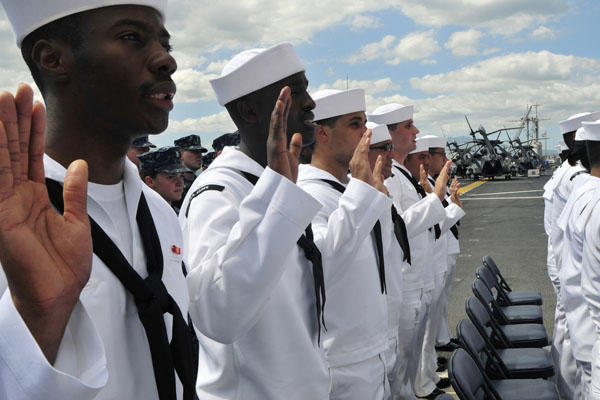The Navy is making progress with the implementation of a series of new personnel initiatives allowing Navy officers and enlisted sailors more opportunities for promotion and offering a wider range of long-term career options for those who stay in the service.
The initiatives, referred to as the Meritorious Advancement Program and Career Intermission Program, were addressed by Navy Secretary Ray Mabus in a speech last month.
"We are moving out to make those tenets a reality in the fleet," said Navy Cmdr. Chris Servello, spokesman for the Chief of Naval Personnel.
The Meritorious Advancement Program, or MAP, is designed to give commanding officers in the Navy a greater ability to decide who gets picked for promotion instead of relying on traditional advancement tests.
The new MAP program, to go into effect by July 1 of this year, gives commanders greater authority to promote the best and brightest within their command ahead of the test.
"We think that commanding officers ought to be able to recognize and promote their best and brightest ahead of the twice a year test - should they deem it appropriate," Servello explained.
In addition, the new MAP program will add new promotion quota numbers to some shore-based commands and also allow commands to give back unused promotion quotas so that other commands can make use of them.
"Last year anywhere from one-third to 50-percent of the quotas went unused. Commands will now be able to give back quotes they have not used and commands will be able to petition for additional quotas" Servello said.
Retention
He explained the service was moving rapidly to implement these and other personnel initiatives announced by Mabus as a way to help improve retention rates for the Navy. The service hope to keep its most talented sailors and officers within its ranks, a task which is increasingly difficult as the economy improves and service members are enticed by the private sector.
"We need to make sure that we're positioned well when trends turn the other way and the economy drives improvements. We need to make sure that we hold on to quality. The old model does not identify quality and does not help us hold on to quality," he said.
This MAP initiative seems particularly significant in light of public criticisms of the Navy's officer promotion process which, critics claimed, wound up excluding a disproportionate number of qualified Naval aviators from advancement. The Navy had already begun exploring adjustments to the process in reaction to these concerns.
The Navy is also hoping to implement a much wider application of its Career Intermission Program, or CIP, an initiative which allows sailors to leave the service for a period of time without losing their career path in the Navy.
The idea is to allow for flexibility and partial alterations of a typical or standard career path in the Navy to allow service members to spend time away from the service in the private sector for periods of time or stagger their sea and shore duty to allow additional time for personal pursuits such as starting a family.
A current provision in the 2016 defense bill added by lawmakers will take the number of CIP slots in the Navy from 40 up to as many as 400, Servello said.
"Moving forward, we hope to work a future legislative proposal that will allow members under CIP to tailor the type of compensation and benefits that they receive in the program," he added.
Maternity Leave
In his May speech at the United States Naval Academy, Annapolis, Md., Mabus also said that women in the Navy will receive twice as much paid maternity leave, received extra hours of child care support, have access to all service professional billets and ultimately wear the same uniform as their male counterparts.
"To make sure you have the time to spend with your newborn, we are proposing legislation that will double paid maternity leave from 6 to 12 weeks starting next year," Mabus said in his remarks, adding that the service needs to recruit more women to make it more representative of the country served by the Navy.
Mabus also said he wanted to expand the number of roles women could perform in the Navy.
"I'm personally committed to opening all operational billets to women," he added. "In all cases, I personally believe we ought to have one standard for both sexes, a standard that matches the demands of the job, and if you pass, you pass."
When it comes to supporting Navy families, Mabus said the service would expand Child Care Development Center services by two hours on both ends of the period now served. Mabus acknowledged that the high op tempo at sea for sailors could take a toll on family life and emphasized that strengthening support to families was important to the Navy.
"That should mean that sailors don't have to worry about child care centers not opening early enough or closing too early. For dual-military couples, who doubly commit to service, we are updating our co-location policy, focusing on much improved opportunity for career progression, joint-service colocation, and active/reserve integration," he said.
Along similar lines, Mabus announced that the Navy will partner with Fortune 500 CEOs to create what's called the "Secretary of the Navy Industry Tour." This program will allow commanders to send their officers to work at U.S. companies for a period of time before returning to the Navy.
Servello also said that the Navy is changing the way it measures body fat as part of its physical fitness assessment standards, something which Mabus also addressed in this speech.
"We will completely revamp the Physical Fitness Assessment. Our pass/fail system that only, and often inaccurately, assesses one aspect of overall fitness will end. We will instead focus on evaluating health, not shape," Mabus said in May.
As part of the prior system, sailors have been required to meet certain weight requirements for specific heights. All sailors need to pass a semi-annual physical fitness assessment. Some of the physical readiness tests for sailors include curl-ups, push-ups and a 1.5-mile run.
The Navy has been working on creating new Body Composition Assessment standards for months now - part of a broader recognition that the antiquated current system needed to be updated. Physical standards for BCA are being revisited because they are decades old and the demographics of the force have substantially changed in recent decades, senior Navy leaders said.
-- Kris Osborn can be reached at kris.osborn@military.com






















